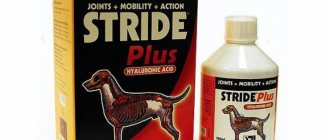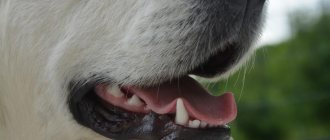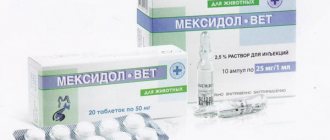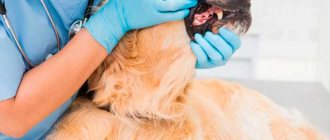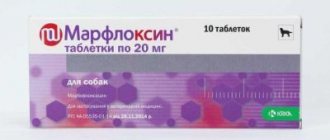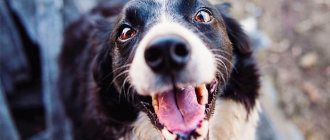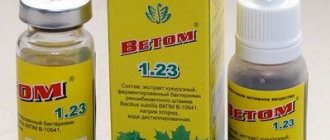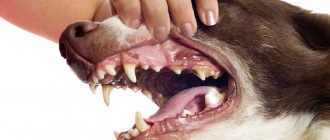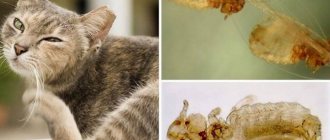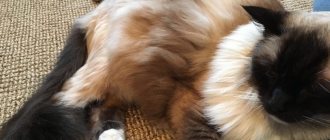Tartar
Tartar is calcareous deposits on the enamel of a dog's teeth.
Symptoms:
- the presence of light brown or yellowish plaque on the teeth;
- sharp unpleasant odor from the mouth;
- abnormally excessive salivation;
- restless and fussy behavior of the animal;
- the pet may frequently click its jaw;
- irritation and inflammation of the oral mucosa;
- frequent vomiting;
- it is possible to discharge a purulent substance from the nostrils or mouth.
Treatment:
1. Brushing teeth with special brushes using pastes and gels for dogs.
2. Using special cleansing seeds immediately after eating.
3. Cleaning and antibacterial treatment in the veterinary clinic.
============================================================================================================================================================================================
Dental and oral diseases in dogs
photo: fotolia.com
It also happens that owners come with a complaint about another problem, and when examining the oral cavity, the veterinarian is horrified: how can the dog still eat with such teeth?! Of all the dogs that owners bring to the veterinarian, approximately 80-85% have fairly serious oral problems.
At a young age, problems with teeth, or more precisely with tooth enamel or gums, can arise due to imbalance in nutrition, lack of minerals, and delayed replacement of baby teeth. In this case, it is better to switch the puppy to ready-made industrial food, in which all nutrients are in the required ratio. Your veterinarian will help you choose the right food based on the individual characteristics of your growing puppy.
In old age, unpleasant odor from the mouth can also be associated with serious internal problems, such as kidney or gastrointestinal diseases, so a full examination of the animal with blood and urine tests is required.
Teeth and gums that are in poor condition are an area where many pathogenic microorganisms and viruses accumulate, which, destroying the tissues of the oral cavity, penetrate through the lymphatic and circulatory system into many internal organs (heart, kidneys, liver).
The condition of the teeth and gums in the oral cavity determines the process of preliminary processing of food under the influence of saliva and the further absorption of nutrients in the stomach and intestines. It is known that dogs with bad teeth bite off large pieces of meat, which leads to a slowdown in the digestion process in the stomach, leading to various disorders of the digestive system.
The condition of the oral cavity in working and hunting dogs affects not only the entire body, but also their working qualities, provokes the early development of disorders and serious diseases, and increases the likelihood of injury. For example, in the work of burrowing dogs, the reliability of the dog’s grip on a fox or raccoon plays an important role, therefore, in the presence of dental diseases, this grip can be involuntarily weakened.
Characteristic signs of disease of the teeth and surrounding tissues:
– halitosis, or unpleasant odor from the mouth;
– painful swelling in the cheekbone, cheek or under the lower jaw;
– enlargement of the submandibular lymph nodes;
– purulent or bloody discharge from the mouth;
– difficulty eating food, the dog chews food or a stick on only one side;
– refusal to fetch objects (or game during hunting), or to hold decoy animals during testing;
– change in the color of tooth enamel (the appearance of dark spots) or gums (from bright red to whitish-yellow with necrotic lesions).
Damage to tooth tissue and gums begins with the deposition of plaque on the tooth enamel. Plaque (an accumulation of bacteria, small particles of food and saliva components) accumulates gradually, layer by layer, and if it is not removed regularly mechanically, it hardens and turns into tartar. Normally, there is some kind of connection between the soft gum tissue and the tooth enamel that prevents food particles and bacteria from entering the space between the gum and tooth. Plaque and tartar destroy tooth tissue, disrupt the connection between the gum and tooth, resulting in a canal appearing in the direction of the tooth root.
| photo: fotolia.com |
Bacteria quickly settle in this canal and behave very aggressively, producing toxic substances that contribute to the appearance of an unpleasant odor and the destruction of tooth and gum tissue.
The accumulation of plaque and the deposition of tartar are facilitated by improper closing of the jaws, delayed replacement of teeth when baby teeth are retained for a long time, improper positioning of teeth, eating only soft foods, and systemic diseases (heart disease, kidney disease, liver disease). PREVENTIVE DENTAL TREATMENT
The dog must be accustomed to examining the oral cavity and mechanically cleaning teeth from plaque from puppyhood. Of course, if the dog is perfectly trained, then it will not be difficult to carry out both an examination of the oral cavity and cleaning of the teeth at any age and at an appointment in a veterinary clinic or at home.
As a rule, cleaning teeth from plaque and tartar is carried out under general anesthesia using an ultrasound machine in a surgical office, especially if there are a lot of deposits and they are located on both the external and internal surfaces of the teeth. But there are cases in practice when there is little tartar (for example, only on the outer surface of the fangs and molars), and if the dog is non-aggressive and allows an examination of the oral cavity, then the veterinarian can perform mechanical removal of tartar without general anesthesia.
Having spent a lot of time and effort (and money) on mechanical or ultrasonic cleaning of your pet’s teeth, you should not forget about this problem again for several years. Carrying out regular cleaning of plaque at least once a month can significantly extend the “lifespan” of teeth and once again avoid subjecting the dog to general anesthesia, which, of course, is not harmless to the health of the animal. In pet stores today you can purchase various dental care products (special gels, pastes, brushes for cleaning teeth).
For those owners who find it unpleasant to clean their teeth on their own, who do not have the time or opportunity to carry out preventive treatment, or whose pet does not allow their mouth to be touched, we can recommend purchasing special bones or cartilage designed for cleaning teeth, or ready-made industrial food that actually provides daily nutrition. mechanical cleaning of teeth. Feeding a special food for cleaning teeth can be done as a preventative measure when the dog’s plaque begins to transform into tartar.
If your dog has problems with his mouth, do not delay a visit to the veterinary clinic. Timely treatment in most cases solves all problems favorably. Don't forget to take the time to examine your pet, including the oral cavity. Often our silent friends suffer from painful sensations, letting us know only when the problem takes threatening turns. We ourselves, sometimes, turn to a doctor only when the disease begins to remind itself every day.
Our four-legged friends rarely complain, so be attentive to them and do not try to solve the problem yourself - this rarely brings any benefit.
Ekaterina Loginova November 8, 2013 at 00:00
Caries
Caries is a lesion of the hard tissues of the tooth, which causes the destruction of enamel and dentin. As this disease progresses, it leads to the formation of cavities in the tooth and, in some cases, to complete or partial destruction of the crown of the tooth.
Symptoms:
- sharp unpleasant odor from the mouth;
- blackening of the tooth surface;
- the appearance of cavities of different sizes in the teeth;
- food particles accumulate in the hollows and gradually rot;
- constant release of excessive amounts of salivary fluid;
- there are obvious disturbances in the chewing process;
- swelling of the gums around the tooth;
- severe pain during palpation;
- teeth may begin to loosen.
Treatment:
Unfortunately, it is impossible to restore dental tissue, but it is possible to stop further tooth decay.
1. Removal of affected areas, staining with special solutions (including silver).
2. Remineralization of the tooth surface.
3. Filling using plastic, cement or special composite materials.
============================================================================================================================================================================================
Why do diseases occur?
Expert dog handlers always examine the animal’s oral cavity during exhibitions. After all, it is its condition that indicates the health of the pet. Often, owners pay insufficient attention to the oral cavity, which leads to tartar deposits and caries.
Most oral pathologies appear due to the fact that dogs are kept in city apartments and do not have the opportunity to chew anything to their heart's content.
In this regard, the load on the jaw is reduced, the process of self-cleaning does not occur, and plaque and tartar form on the animal’s teeth, which leads to caries.
Oral diseases most often occur:
- in small breed dogs in 70-85% of cases;
- for medium-sized ones, 65-70%;
- for large ones it is 45-50%.
Periodontal disease
Periodontal disease is damage to the periodontal tissue (periodontal tissue).
Symptoms:
— Very strong unpleasant odor from the dog’s mouth.
- Increased salivation, sometimes blood can be found in the salivary fluid.
— An animal may refuse to eat or, conversely, react violently to food, but eat carefully and slowly.
— The gums may turn red, and the teeth become wobbly and may gradually begin to fall out.
Treatment:
1. Ensure your pet receives the maximum amount of vitamins and nutrients contained in the right foods. 2. Also, treatment of this disease involves taking antibiotics. Commonly used drugs are metronidazole, clavulanate and glucocorticoids.
3. Filling or removing a tooth if it is impossible to cure.
============================================================================================================================================================================================
Pulpitis in dogs
Pulpitis is an inflammation of dental tissue (blood, lymphatic vessels, nerve plexuses and fiber) in the tooth canal.
Etiology. Inflammation of the pulp develops as a result of mechanical damage to dentin, caries, stones, tooth fractures, premature abrasion of the crown, etc.
Under the influence of an irritant, an inflammatory process develops in the pulp, which is often complicated by the penetration of infection and turns into a purulent gangrenous or granulomatous form. According to the course, pulpitis can be acute and chronic.
Clinical signs are accompanied by a violation of the act of chewing food, sharp pain when tapping on a sore tooth. With gangrenous inflammation, inspection reveals a carious cavity containing a dirty-gray fetid mass. Granulomatous pulpitis has a chronic course and is characterized by the proliferation of granulation tissue that protrudes through the hole in the tooth in the form of wild meat.
Stomatitis
Stomatitis is characterized by inflammation of the oral mucosa.
Symptoms:
- The initial stage of the disease is characterized by inflammation and redness of the mucous membrane. It may also be covered with a grayish coating. A careful inspection may reveal plaque.
- An unpleasant odor is heard from the dog's mouth, reminiscent of rotten meat or rotten vegetables.
- The animal becomes lethargic and depressed.
- The dog may frequently rub its head against objects or its chest, sneeze frequently, and act restless.
- In some cases, fever may occur.
- Too much saliva comes out of the mouth. It also becomes foamy and stringy. Sometimes ichor and pus can be found in the liquid.
- Ulcers and pimples may appear in the dog's mouth.
- If the disease occurs due to the deposition of stones, tooth roots become visible.
- There is bleeding in the gums.
- With stomatitis, teeth can become very loose.
- In some cases, the disease also affects the larynx and tongue.
Treatment:
1. Removing residual pus from the oral cavity.
2. Suppressing infection with antibiotics.
3. Lugol's solution and special dental ointments using Metrogyl will help to heal lesions, as well as protect the mucous membrane from the negative effects of microbes.
4. Restoration of the animal’s immune system.
5. “Soft” diet to avoid further injury to the mouth. The animal's diet can include liquid porridges, decoctions, jellies, milk and jelly.
============================================================================================================================================================================================
Signs to suspect stomatitis in a dog
- The animal drinks a lot, often and quickly. The inflammatory process in the oral cavity is usually accompanied by a burning sensation, which is alleviated by drinking.
- Profuse drooling. Saliva flows constantly, but the act of swallowing is not impaired. While eating, a distinct slurping sound can be heard.
- Decreased appetite and caution when eating food. The dog refuses solid food or eats it very carefully, chewing it slowly. Some time later, the pet may refuse food altogether, even its favorite food.
- The animal periodically rubs its muzzle against objects, makes sounds reminiscent of sneezing, and an unpleasant (rotten or putrid) smell begins to come from its mouth.
- The pet may be lethargic, inactive, and may have an increase in body temperature.
